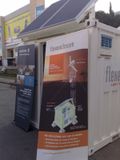The other day, a reader asked whether it is true that a voice call over a UMTS circuit switched bearer is less expensive than over a packet switched UMTS bearer. Good question and I guess very difficult to answer as there are many parameters. But nevertheless, let's expand the question and put GSM and LTE on top.
GSM
In the GSM world things were simple at first. There's a 200 kHz carrier and you can squeeze 8 timeslots into it. On the main carrier of a cell 6 out of those 8 timeslots can be used for voice, on all others, all timeslots can carry one voice call. Further, the adjacent carrier can't be used due to overlap, so the carriers bandwith is effectively 400 kHz. To increase the number of calls, the network operator can use AMR half rate, theoretically doubling voice capacity. Here it starts to get difficult as a half rate channel should not be used under weak signal conditions, i.e. some calls should fall back to a full rate channel so more redundancy and error correction information can be added to prevent the call from dropping. Anyway, a full rate channel voice coded streams at 12 kbit/s in each direction. Add error detection and correction bits and you end up with around 28 kbit/s.
UMTS Circuit Switched
In terms of resource use, things are similar as in GSM. The AMR full rate codec streams at around 12 kbit/s and redundancy information is added. I'd say resource use is similar as in GSM.
UMTS / HSPA Packet Switched
Packet switched means Voice over IP. Here, things start to get difficult because what is VoIP in practice? There's no standard solution as in the wireless circuit switched domain so there are different possibilities.
Let's look at standard SIP first that uses the 64 kbit/s uncompressed PCM codec. Add IP overhead and you stream at 80 kbit/s in each direction. Quite a difference to the 12 kbit/s used in the circuit switched wireless network. But wait, it's 28 kbit/s due to error detection and correction. However, that has to be added to the 80 kbit/s as well but how much, that's difficult to say. That depends how far the user is away from the base station, i.e. which modulation and coding is used. So to get realistic values, you have to calculate with a traffic mix. But no matter how you calculate it, there's no way to bring the 80 kbit/s down to the circuit switched value.
Some SIP implementations also use AMR if they detect that both ends support it. That brings down the data rate to 12 kbit/s + IP overhead to a total of 32 kbit/s. For details see this post. Still three times more than 'native' AMR. For users very close to the base station not a lot of redundancy needs to be added so I think we could come pretty close to GSM or be even better. But then, you switch-on half rate AMR and GSM is doing better once again. You could do that in VoIP as well but the IP overhead won't go down and it's already 2/3rds of the total bandwidth for full rate AMR.
Better spectral efficiency could also help to some extent to compensate for higher VoIP data rates as mobiles close to the base station do not only require less error detection and correction bits in the stream but can also use a higher order modulation, thus making the transmission more efficient than GSM circuit switched. But again, that's only for some but not all mobile devices.
Something that works against VoIP efficiency over wireless networks are channel assignments. While circuit switched timeslots are only assigned at the beginning of the call, bandwidth for VoIP calls over HSPA needs to be frequently re-assigned. There were some efforts in 3GPP to reduce the need by using static assignments but it starts getting messy quite quickly here (HS-SCCH-less operation).
But wait, there's IP header compression in UTMS, at least in theory. In practice, however, it's not used as far as I know, so I won't put that into the equation.
Over the top VoIP such as Skype uses pretty bandwidth efficient codecs that are in a similar bandwidth requirement range as AMR. There are lots of VoIP systems that could be used over wireless as well but I don't know what kind of bandwidth needs they have so I won't discuss them here.
LTE
There's a real pressure with LTE to switch to VoIP and similar dependencies on features such as modulation and coding, signaling overhead, etc. as in UMTS will have an impact. Robust header compression will probably make it into LTE much faster than in UMTS, be it for IMS, for VOLGA, or for any other network operator voice solution that will be used.
The Calculations
The book from Hari Holma and Antti Toskala on UMTS/HSPA has some interesting calculation on VoIP capacity. Their conclusion is that UMTS packet switched voice capacity can easily exceed that of GSM – if, and that's the big if, all optimizations are present and switched-on. For over the top VOIP, however, it's unlikely that these conditions will be met.
Summary
So as you have seen VoIP over UMTS or LTE can be more or less efficient than circuit switched voice over GSM depending on how you look at it. So maybe the question for the future will not be on efficiency but if mobile network operators will in the future continue to be the main provider of wireless voice calls or if over the top voice providers will take a bigger share of the market for which radio network optimizations are not working as efficiently.

